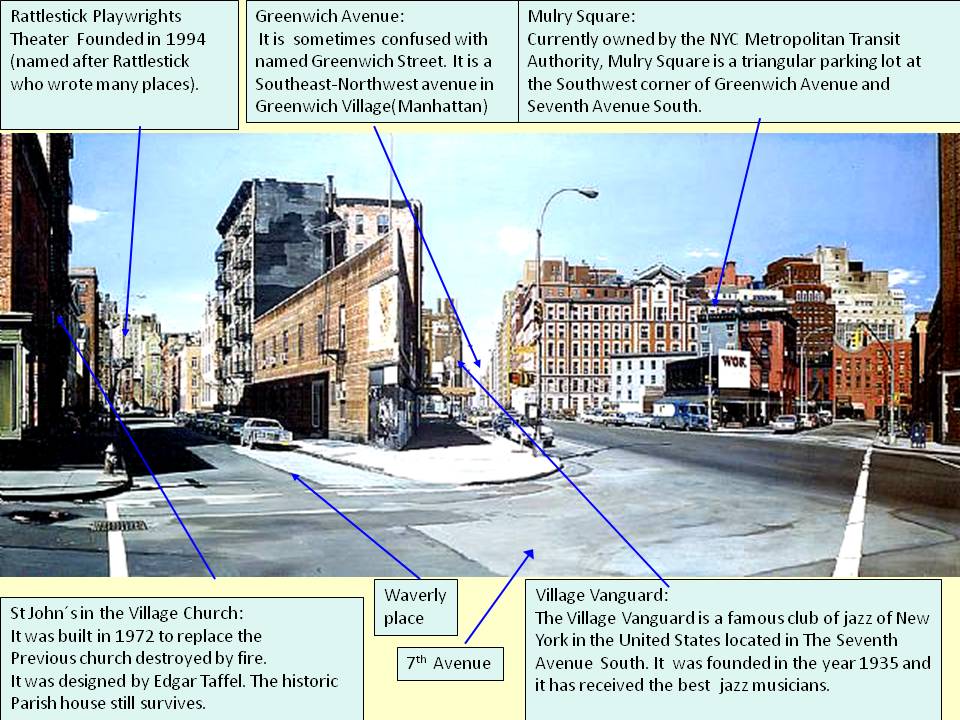This image is a photorealistic picture in oil on canvas by Richard Estes (1980). It is an almost seven-foot-wide panoramic of an intersection in Greenwich Village. The painting is facing North on Seventh Avenue South on a bright, clear day. We can see the location of a jazz club, the Village Vanguard, and parked cars. Regarding traffic, usually the street is full of cars, trucks, buses, and taxis but in the painting there is no traffic. The painter forces us to focus on the buildings, which are presented with a photographical detail. For example, the two-story building on the island reminds us of the prow of a ship. This is a type of realist painting called Photorealism which content is based on photographs or a photographic way of seeing the city. This style started in the USA in the late 1960’s.
As we said before, this picture portraits Waverly Place that is in Greenwich Village, a part of New York. The urban layout of New York is grid plan where in the picture we can see two big Avenues and this is because the city of New York is structured by big wide and long Avenues. The difference between the urban layout of Greenwich Village and New York is that In New York there are skyscrapers because it is the center of the city, but Greenwich Village is in the surrounding of the center because it started as a residential area.
Greenwich village was a farmland and the village grew rapidly because many people came from Manhattan due to epidemics. Nowadays Greenwich Village is a large residential area on the West side of Manhattan in New York. New Yorkers did not consider Greenwich Village as a city; for them anywhere that was on the West of the East Village was simply «The Village». In the early eighteenth century, this area was a village neighboring Dutch settlers in New York, another «village» and hence the name. However with the Northward expansion of the city it ended up annexing to Manhattan. The neighborhood is surrounded by Broadway to the East, the Hudson River to the West, Houston Street to the South and 14th Street to the North. The Greenwich Village Historic District has been listed on the National Register of Historic Places since June 19, 1979.
Originally the district was created in 1712. In 1822, the yellow fever epidemic in New York caused the residents to move to Greenwich Village looking for fresh air. During the Revolutionary Period, General George Washington had his headquarters in The Village. Later, Vice President John Adams placed his residence there. In the 19th century, a new street plan was established. But The Village, where winding streets already existed, was left untouched.
Regarding buildings, in the picture we can see many places related with social activities, where people passed their free time, for example, the “Rattlestick” theatre , the Village Vanguard (a jazz club), St John´s in the Village Church. The main building of the picture, that looks like the prow of a ship, was completed by the local artisan Bayard John Tucker in 1831 and a third floor was added in 1854. We can notice a slight change in the color and layout of the bricks above the second floor. In 1831 it became a dispensary for poor people. The most famous patient was Edgar Allen Poe, who was treated for a head cold in 1837. In 1960 it became a dental clinic (it was in this time when Richard Estes painted this picture). In 1986 they refused to treat a patient who was HIV-positive; the clinic was sued for that reason and since 1997 it has been a shelter for people with disabilities.
Another interesting building is St John’s in the Village Church: This is an Episcopal Church; its roots can be traced to the congregation of St. Jude’s Free Episcopal Church, which was located in what is now the Waverly Theatre until 1853. In addition, Greenwich Village attracted writers and intellectuals since its beginnings. By 1910 there was a combination of literary talent, independent thinkers interested in social reform, and «bohemian» artists in the area.
Carmen Gutiérrez Cabrera

